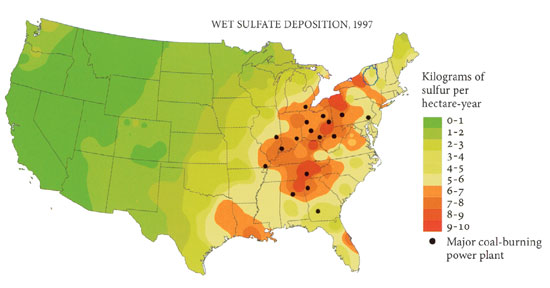Short takes on two books
By David Schneider, Amos Esty
Acid Rain in the Adirondacks: An Environmental History and The Physics of NASCAR: How to Make Steel + Gas + Rubber = Speed
Acid Rain in the Adirondacks: An Environmental History and The Physics of NASCAR: How to Make Steel + Gas + Rubber = Speed

DOI: 10.1511/2008.71.260
ACID RAIN IN THE ADIRONDACKS: An Environmental History. Jerry Jenkins, Karen Roy, Charles Driscoll and Christopher Buerkett. Cornell University Press, $65 (cloth), $29.95 (paper).

From Acid Rain in the Adirondacks.
The threat of climate change has in recent years overshadowed concerns about acid rain, but there are reasons not to forget about it entirely. For one thing, it's still a problem. The authors of Acid Rain in the Adirondacks explain the process by which the sulfur and nitrogen oxides spewing from power plants in the Midwest make their way into northeastern ecosystems. The book reviews hundreds of studies of what this phenomenon has wrought in the Adirondacks, pointing out, for example, that as the acidity of a lake increases, the number of species of fish decreases.
But another reason to pay attention is that there's good news: Emissions of sulfur peaked a few years after the passage of the Clean Air Act in 1970 and have since declined by about half. The authors worry that these positive trends may not continue—and, even if they do, it will be several decades before many affected ecosystems recover. Still, they say, the regulation of sulfur emissions has been "a major public achievement."
Hundreds of technical charts, diagrams and maps (like the one above) complement the book's clear explanations of the science of acid deposition, so it should appeal to professional as well as lay readers. Acid Rain in the Adirondacks chronicles everything that can go wrong when attending to environmental problems is put off for too long, but it also offers evidence that dangers can be addressed successfully through scientific research, public awareness and government regulation.—Amos EstyTHE PHYSICS OF NASCAR: How to Make Steel + Gas + Rubber = Speed. Diandra Leslie-Pelecky. Dutton, $25.95.
Although fans of football, baseball, basketball or hockey may cringe at the thought, the top spectator sport in the United States is arguably the one overseen by NASCAR (National Association for Stock Car Auto Racing). So it's high time such titles as The Physics of Baseball and The Physics of Football got a little competition for the attention of technically minded sport enthusiasts. Diandra Leslie-Pelecky has taken on that challenge, producing The Physics of NASCAR. The book is appropriate for readers with only a high-school education—which should make it a good vehicle for getting car-crazy teenagers interested in science and technology.

From The Physics of NASCAR.
As the title promises, the book covers the physics behind this highly technical sport. For example, it reports on the computational fluid dynamics used to understand and exploit the aerodynamics of driving at nearly 200 miles an hour. (At such speeds, close drafting, as shown in the bottom panel of the illustration at left, reduces drag on both cars so that they can go 3 to 5 miles per hour faster.) Another chapter discusses the metallurgy involved in casting the block for an 800-horsepower engine. Parts of the book touch on chemistry, too—for example, of the rubber in tires and of the polymers used in the fire-retardant suits drivers wear.
More surprisingly, Leslie-Pelecky also probes the personalities of the people who race for a living. Here she unabashedly jettisons any sense of journalistic detachment, embedding herself in a NASCAR team to give the reader an insider's take on its trials and tribulations. Although it's understandable that she wanted to report what she witnessed, her efforts here fail. Rather than giving a nuanced account of a very curious subculture, she merely provides cheerleading for the sport and its participants.—David Schneider
Click "American Scientist" to access home page
American Scientist Comments and Discussion
To discuss our articles or comment on them, please share them and tag American Scientist on social media platforms. Here are links to our profiles on Twitter, Facebook, and LinkedIn.
If we re-share your post, we will moderate comments/discussion following our comments policy.